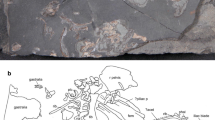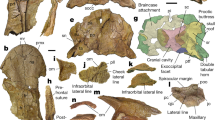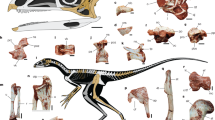Abstract
The fossil record of early tetrapods has been increased recently by new finds from the Devonian period1 and mid–late Early Carboniferous period2. Despite this, understanding of tetrapod evolution has been hampered by a 20-million-year gap (‘Romer's Gap’3) that covers the crucial, early period when many key features of terrestrial tetrapods were acquired. Here I describe the only articulated skeleton of a tetrapod, Pederpes, yet found from the Tournaisian epoch (354–344 million years ago (Myr)). The new taxon includes a pes with five robust digits, but a very small, possibly supernumerary digit preserved on the manus suggests the presence of polydactyly. Polydactylous early tetrapods may have survived beyond the end of the Devonian and pentadactyly cannot be assumed for the pes. However, the pes has characteristics that distinguish it from the paddle-like feet of the Devonian forms and resembles the feet of later, more terrestrially adapted Carboniferous forms. Pederpes is the earliest-known tetrapod to show the beginnings of terrestrial locomotion and was at least functionally pentadactyl. With its later American sister-genus, Whatcheeria4,5, it represents the next most primitive tetrapod clade after those of the Late Devonian, bridging the temporal, morphological and phylogenetic gaps that have hitherto separated Late Devonian and mid-Carboniferous tetrapod faunas.
This is a preview of subscription content, access via your institution
Access options
Subscribe to this journal
Receive 51 print issues and online access
$199.00 per year
only $3.90 per issue
Buy this article
- Purchase on Springer Link
- Instant access to full article PDF
Prices may be subject to local taxes which are calculated during checkout





Similar content being viewed by others
References
Clack, J. A. in Amphibian Biology (eds Heatwole, H. & Carroll, R. L.) 979–1029 (Surrey Beatty, Chipping Norton, Australia, 2000)
Clack, J. A. & Carroll, R. L. in Amphibian Biology (eds Heatwole, H. & Carroll, R. L.) 1030–1043 (Surrey Beatty, Chipping Norton, Australia, 2000)
Coates, M. I. & Clack, J. A. in Studies on Early Vertebrates (eds Arsenault, M., Lelièvre, H. & Janvier, P.) 373–388 (Bulletin du Muséum National d'Histoire Naturelle, Paris, 1995)
Lombard, R. E. & Bolt, J. R. A new primitive tetrapod, Whatcheeria deltae, from the Lower Carboniferous of Iowa. Palaeontology 38, 471–494 (1995)
Bolt, J. R. & Lombard, R. E. in Amphibian Biology (eds Heatwole, H. & Carroll, R. L.) 1044–1052 (Surrey Beatty, Chipping Norton, Australia, 2000)
Paterson, I. B., Hall, I. H. S. & Stephenson, D. British Geological Survey, Geology of the Greenock district (Her Majesty's Stationery Office (HMSO), London, 1990)
Cameron, I. B. & Stephenson, D. British Geological Survey, British Regional Geology; The Midland Valley of Scotland (Her Majesty's Stationery Office (HMSO), London, 1985)
Clack, J. A. Earliest known tetrapod braincase and the evolution of the stapes and fenestra ovalis. Nature 369, 392–394 (1994)
Clack, J. A. The neurocranium of Acanthostega gunnari and the evolution of the otic region in tetrapods. Zool. J. Linn. Soc. 122, 61–97 (1998)
Milner, A. C. & Lindsay, W. Postcranial remains of Baphetes and their bearing on the relationships of the Baphetidae ( = Loxommatidae). Zool. J. Linn. Soc. 122, 211–235 (1998)
Coates, M. I. & Clack, J. A. Polydactyly in the earliest known tetrapod limbs. Nature 347, 66–69 (1990)
Coates, M. I. The Devonian tetrapod Acanthostega gunnari Jarvik: postcranial anatomy, basal tetrapod relationships and patterns of skeletal evolution. Trans. R. Soc. Edinb. Earth Sci. 87, 363–421 (1996)
Godfrey, S. J. The postcranial skeletal anatomy of the Carboniferous tetrapod Greererepton burkemorani Romer, 1969. Phil. Trans. R. Soc. Lond. B 323, 75–133 (1989)
Clack, J. A. Silvanerpeton miripedes, a new anthracosauroid from the Viséan of East Kirkton, West Lothian, Scotland. Trans. R. Soc. Edinb. Earth Sci. 84, 369–376 (1994)
Holmes, R. The Carboniferous amphibian Proterogyrinus scheeli Romer, and the early evolution of tetrapods. Phil. Trans. R. Soc. Lond. B 306, 431–524 (1984)
Swofford, D. L. PAUP: Phylogenetic analysis using parsimony Version 3.1. (distributed by the Illinois Natural History Survey, Champaign, Illinois, 1993)
Maddison, W. P. & Maddison, D. R. MacClade Version 3.0 Analysis of phylogeny and character evolution (Sinauer, Sunderland, Massachusetts, 1992)
Carroll, R. L. in Studies On Early Vertebrates (eds Arsenault, M., Lelièvre, H. & Janvier, P.) 389–445 (Bulletin du Muséum National d'Histoire Naturelle, Paris, 1995)
Lebedev, O. A. & Coates, M. I. The postcranial skeleton of the Devonian tetrapod Tulerpeton curtum Lebedev. Zool. J. Linn. Soc. 114, 307–348 (1995)
Laurin, M. & Reisz, R. in Amniote origins—completing the transition to land (eds Sumida, S. & Martin, K. L.) 9–59 (Academic, London, 1997)
Clack, J. A. A new Lower Carboniferous tetrapod with a mélange of crown group characters. Nature 394, 66–69 (1998)
Paton, R. L., Smithson, T. R. & Clack, J. A. An amniote-like skeleton from the Early Carboniferous of Scotland. Nature 398, 508–513 (1999)
Anderson, J. S. The phylogenetic trunk: maximal inclusion of taxa with missing data in an analysis of the Lepospondyli (Vertebrata, Tetrapoda). Syst. Biol. 50, 170–193 (2001)
Panchen, A. L. On the amphibian Crassigyrinus scoticus Watson from the Carboniferous of Scotland. Phil. Trans. R. Soc. Lond. B 309, 461–568 (1985)
Acknowledgements
I thank J. Richardson at the Natural History Museum, London, for spore-analysis dating the specimen, J. Jeffery for bringing the specimen to my notice, and E. Lombard and J. Bolt for access to the specimens of Whatcheeria. I also thank M. Coates, M. Ruta, P. Upchurch and A. Warren for discussion and analysis of the phylogeny, and the NERC for funding the research project, including the preparation and photography by S. M. Finney.
Author information
Authors and Affiliations
Ethics declarations
Competing interests
The author declares no competing financial interests.
Rights and permissions
About this article
Cite this article
Clack, J. An early tetrapod from ‘Romer's Gap’. Nature 418, 72–76 (2002). https://doi.org/10.1038/nature00824
Received:
Accepted:
Issue Date:
DOI: https://doi.org/10.1038/nature00824
This article is cited by
-
Fossil bone histology reveals ancient origins for rapid juvenile growth in tetrapods
Communications Biology (2022)
-
Longest-surviving Carboniferous-family insect found in Mesozoic amber
Biologia (2022)
-
Hidden morphological diversity among early tetrapods
Nature (2017)
-
Phylogenetic and environmental context of a Tournaisian tetrapod fauna
Nature Ecology & Evolution (2016)
-
The phantoms of a high-seven - or - why do our thumbs stick out?
Frontiers in Zoology (2015)
Comments
By submitting a comment you agree to abide by our Terms and Community Guidelines. If you find something abusive or that does not comply with our terms or guidelines please flag it as inappropriate.



